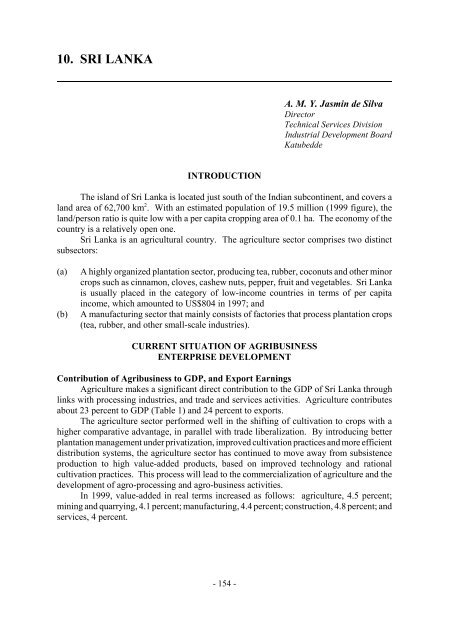Development of Agribusiness Enterprises - Asian Productivity ...
Development of Agribusiness Enterprises - Asian Productivity ...
Development of Agribusiness Enterprises - Asian Productivity ...
Create successful ePaper yourself
Turn your PDF publications into a flip-book with our unique Google optimized e-Paper software.
10. SRI LANKA<br />
INTRODUCTION<br />
- 154 -<br />
A. M. Y. Jasmin de Silva<br />
Director<br />
Technical Services Division<br />
Industrial <strong>Development</strong> Board<br />
Katubedde<br />
The island <strong>of</strong> Sri Lanka is located just south <strong>of</strong> the Indian subcontinent, and covers a<br />
land area <strong>of</strong> 62,700 km 2 . With an estimated population <strong>of</strong> 19.5 million (1999 figure), the<br />
land/person ratio is quite low with a per capita cropping area <strong>of</strong> 0.1 ha. The economy <strong>of</strong> the<br />
country is a relatively open one.<br />
Sri Lanka is an agricultural country. The agriculture sector comprises two distinct<br />
subsectors:<br />
(a) A highly organized plantation sector, producing tea, rubber, coconuts and other minor<br />
crops such as cinnamon, cloves, cashew nuts, pepper, fruit and vegetables. Sri Lanka<br />
is usually placed in the category <strong>of</strong> low-income countries in terms <strong>of</strong> per capita<br />
income, which amounted to US$804 in 1997; and<br />
(b) A manufacturing sector that mainly consists <strong>of</strong> factories that process plantation crops<br />
(tea, rubber, and other small-scale industries).<br />
CURRENT SITUATION OF AGRIBUSINESS<br />
ENTERPRISE DEVELOPMENT<br />
Contribution <strong>of</strong> <strong>Agribusiness</strong> to GDP, and Export Earnings<br />
Agriculture makes a significant direct contribution to the GDP <strong>of</strong> Sri Lanka through<br />
links with processing industries, and trade and services activities. Agriculture contributes<br />
about 23 percent to GDP (Table 1) and 24 percent to exports.<br />
The agriculture sector performed well in the shifting <strong>of</strong> cultivation to crops with a<br />
higher comparative advantage, in parallel with trade liberalization. By introducing better<br />
plantation management under privatization, improved cultivation practices and more efficient<br />
distribution systems, the agriculture sector has continued to move away from subsistence<br />
production to high value-added products, based on improved technology and rational<br />
cultivation practices. This process will lead to the commercialization <strong>of</strong> agriculture and the<br />
development <strong>of</strong> agro-processing and agro-business activities.<br />
In 1999, value-added in real terms increased as follows: agriculture, 4.5 percent;<br />
mining and quarrying, 4.1 percent; manufacturing, 4.4 percent; construction, 4.8 percent; and<br />
services, 4 percent.
















